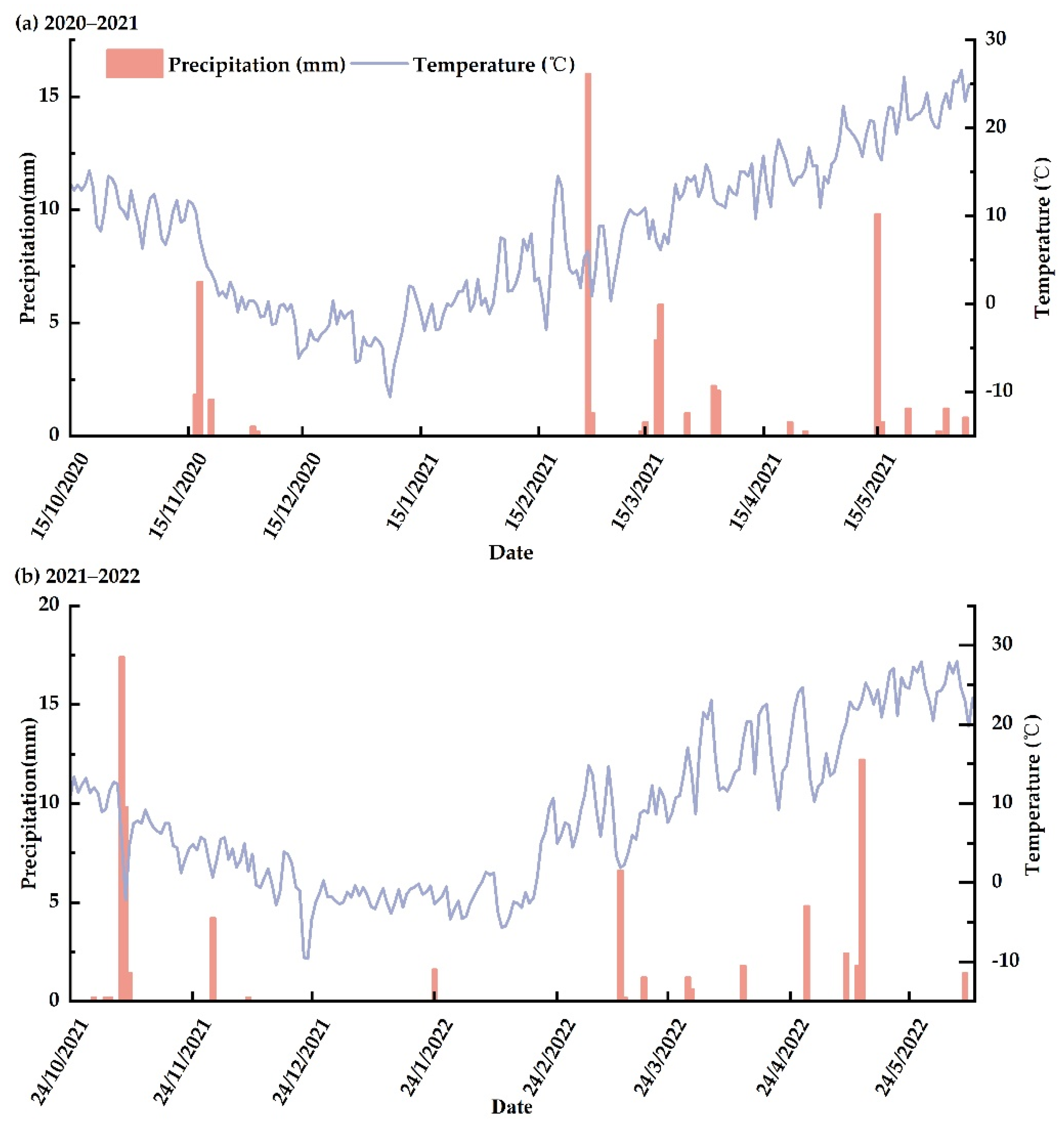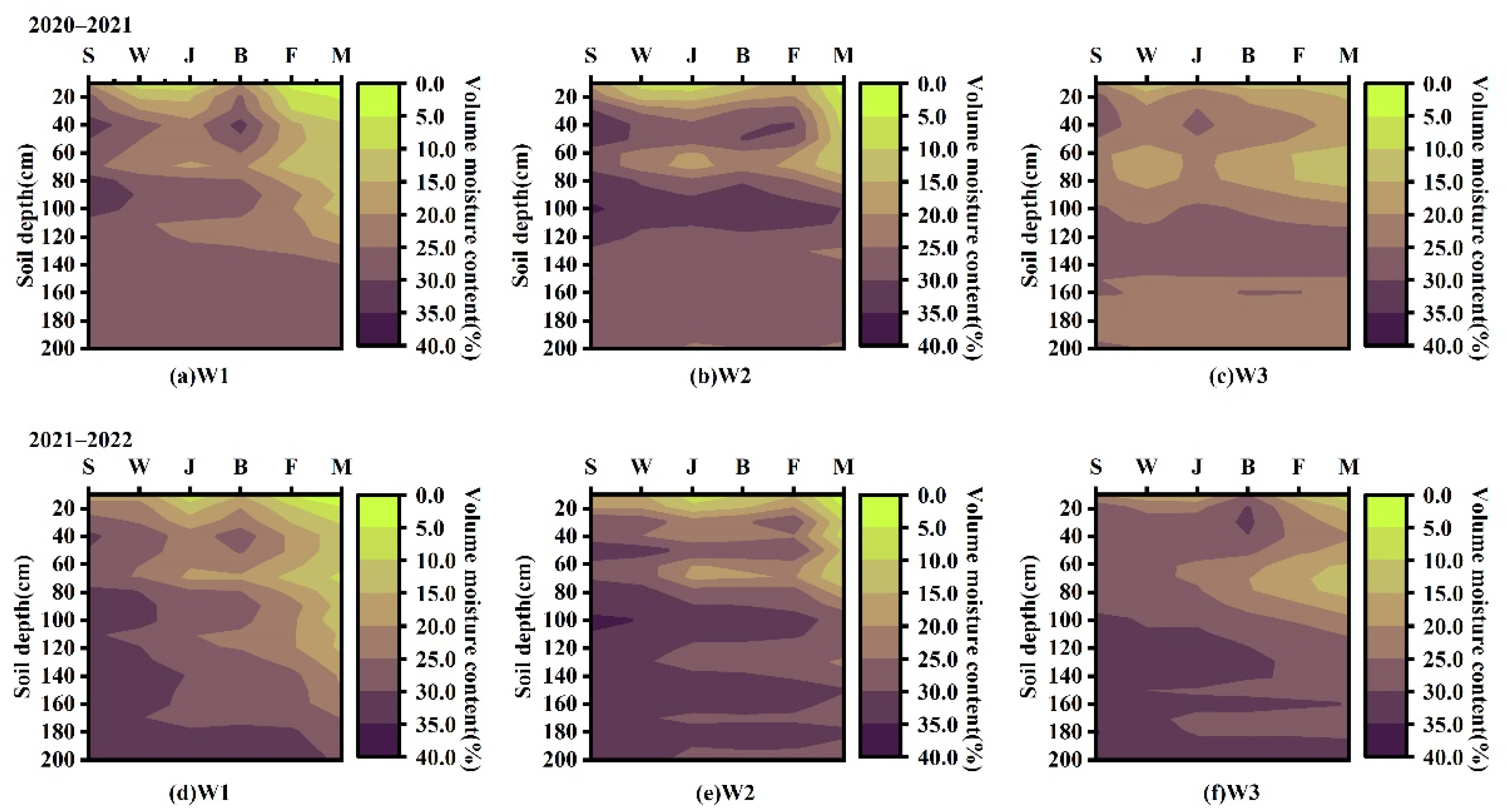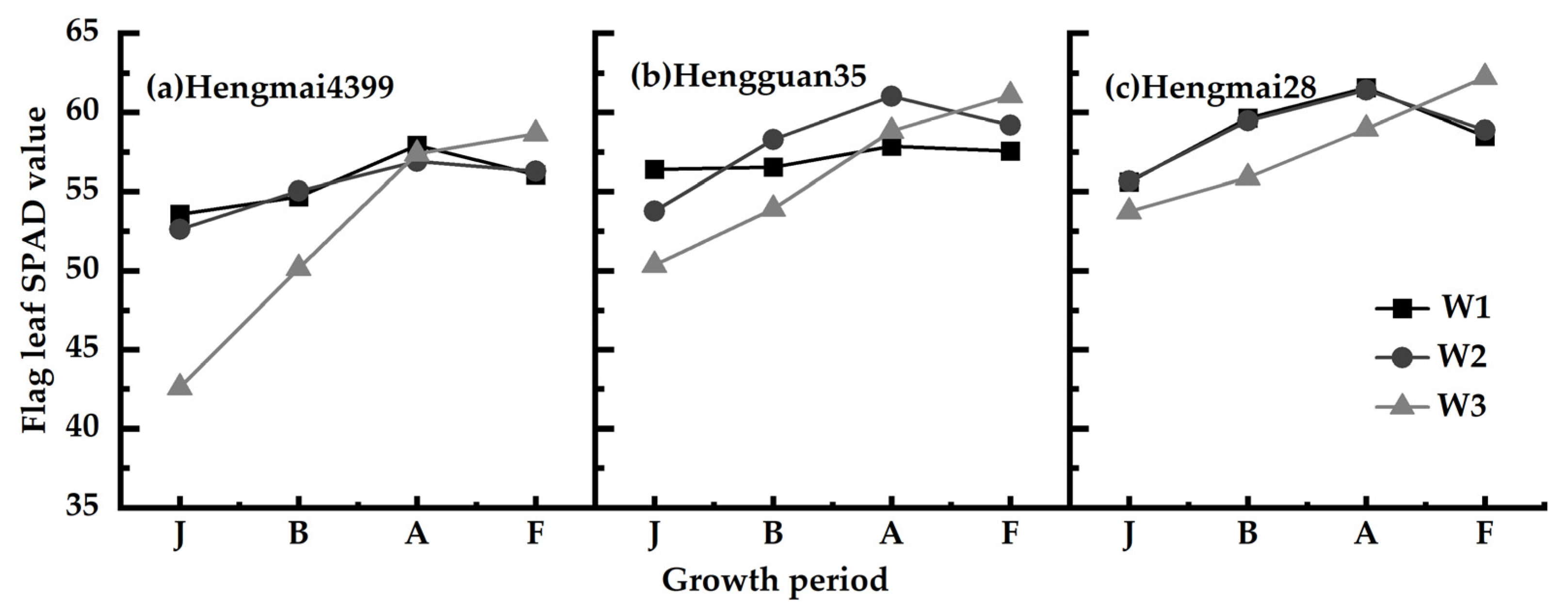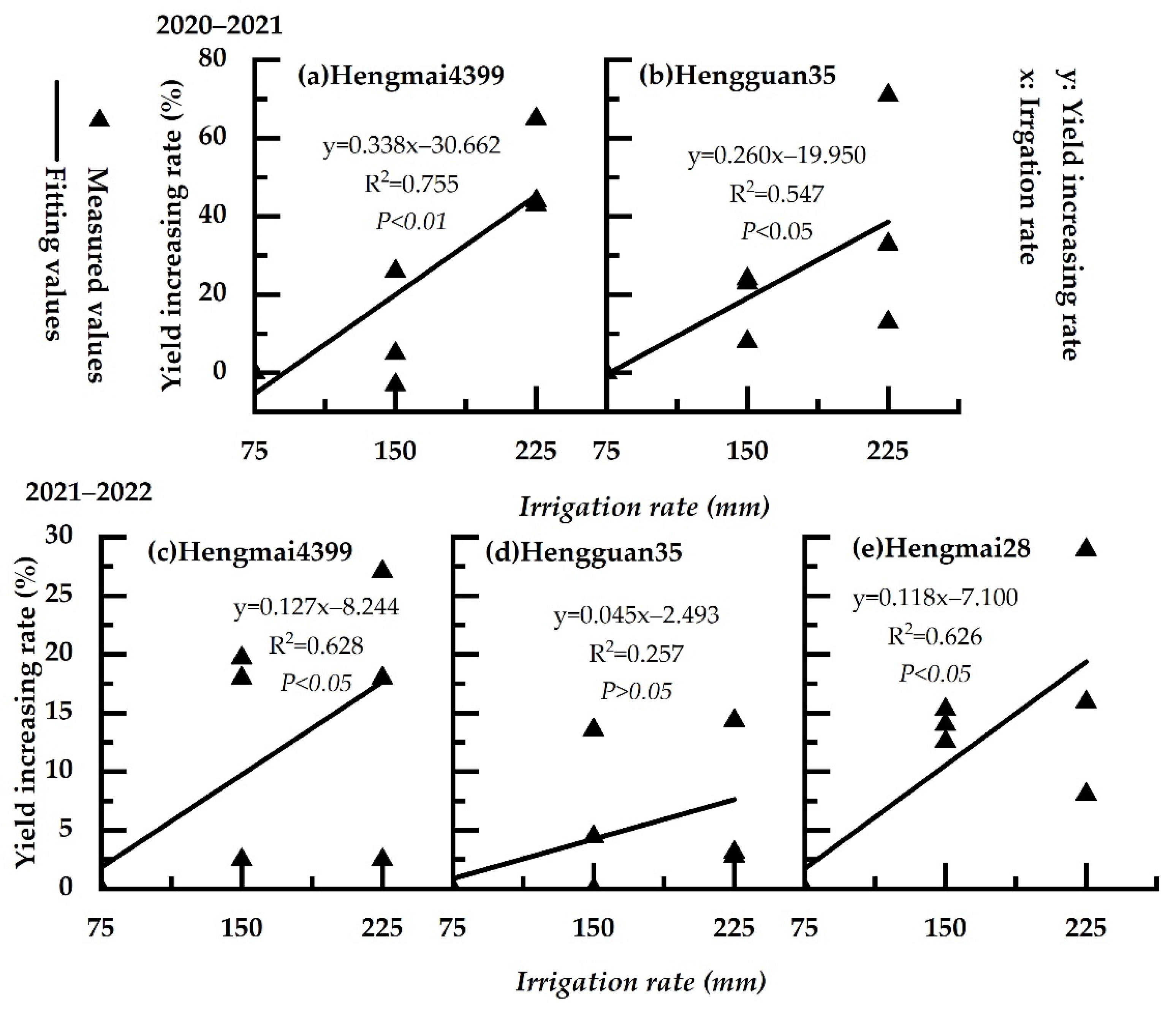1. Introduction
At present, water shortage is one of the key concerns in China, and the uneven distribution of water resources is one of the main causes of regional water shortages in China. The current water resource situation in China is generally “flooding in the south and drought in the north”. Agriculture accounts for 61.50% of China’s total water consumption [
1]. Grain produced in the North China Plain (NCP) accounts for a large proportion of China’s grain production [
2]. Winter wheat (
Triticum aestivum L.) is a main food crop in the NCP [
3]. Due to the influence of monsoons, the coupling of precipitation distribution and water demand of winter wheat in this region is poor, and the precipitation during the reproductive period is less than 40% of its water demand [
4]. Therefore, a large amount of groundwater is consumed for winter wheat planting in the area, and the groundwater has been seriously overexploited. When the irrigation amount reaches a certain level, the winter wheat yield and the water use efficiency (WUE) will decrease [
5]. Thus, irrigation systems need to be optimized to reduce groundwater extraction, improve WUE, and maintain stable winter wheat yields.
Winter wheat yield does not increase linearly with the increasing amount of irrigation, and the yield is influenced by the amount of rainfall and growth stage distribution [
6]. By optimizing the irrigation system, the water consumption of 40.00–50.00 mm during the whole winter wheat growing period can be reduced, thereby ensuring food security in the NCP, but the annual water consumption is still greater than the groundwater recharge [
7,
8]. On this basis, researchers supplemented soil water storage to the field capacity of the upper soil layer of root zone presowing; then, the annual water consumption was reduced by 112.00 mm while the yield was maintained at 86.00% without irrigation throughout the winter wheat growth period [
9]. One of the main reasons why modern winter wheat varieties are more resistant to drought than earlier varieties is their greater ability to utilize soil water [
10]. Thus, ensuring sufficient presowing soil water storage under water-limited irrigation is an important condition for maintaining high yield of winter wheat [
11].
Winter wheat growth under dry land conditions is more dependent on deep soil water storage during the filling period [
12], and it has been shown that sufficient water supply during the filling period can enhance the greenness of wheat leaves and thus promote the dry matter accumulation of winter wheat [
13]. Roots of winter wheat show a very positive response to irrigation, with the near-surface root system playing a major role, and light high-frequency irrigation can reduce deep seepage and ensure that the wheat is not influenced by water deficit while promoting the development of shallow roots, thus improving the WUE of wheat and achieving efficient water use [
14,
15,
16]. Li et al. [
17] found that when the irrigation amount is 120 mm, 60 mm irrigation at the jointing stage and booting stage can improve the yield and WUE of wheat significantly. However, more frequent irrigation will increase soil evaporation; thus, balancing single irrigation volume and irrigation frequency under a certain amount of irrigation is important to improve the WUE and maintain winter wheat yield [
18,
19].
Considering the current situation of water resource security and food security in the NCP, the irrigation amount of winter wheat should be increased to more than the minimum irrigation amount for sustainable food production but less than the current irrigation amount that causes the rapid decline in groundwater level. Among the existing studies, individual studies on the water consumption characteristics of different wheat varieties and the effect of irrigation on yield and the WUE of wheat have been frequent, but few studies have been reported to combine winter wheat varieties with irrigation systems to investigate the response to irrigation of different winter wheat varieties under different irrigation systems.
Additionally, although researchers in previous studies have concluded that adequate presowing soil water storage is an important factor for high wheat yield [
11], they have not explored in depth how presowing soil water storage affects the water consumption characteristics of winter wheat in different soil layers. Thus, for this study, three winter wheat varieties were selected, and three water treatments were set up to explore the differences in water consumption rules and yield traits among varieties under different irrigation systems. In addition, due to the influence of the previous year’s experiment, the presowing soil moisture storage of W3 treatment in 2020–2021 differed significantly from the other treatments [
20]; therefore, this study was able to complement the effect of presowing soil moisture storage on the spatial water consumption characteristics in winter wheat.
2. Materials and Methods
2.1. Test Site Overview
The experiments were conducted at the dryland water-saving experimental station of the Hebei Academy of Agricultural and Forestry Sciences (37°44′ N, 115°47′ E) from October 2020 to June 2021 and from October 2021 to June 2022. In the two-year experiment, the rainfall and temperature during the winter wheat growth period are shown in
Figure 1. The test soil was a clay loam with a soil bulk weight of 1.40 g cm
−3. At 0–20 cm, the soil organic matter, total nitrogen, available nitrogen, available phosphorus, available potassium, and soil pH were 24.50 g kg
−1, 1.52 g kg
−1, 106.58 g kg
−1, 28.62 g kg
−1, 187.20 g kg
−1, and 8.01, respectively.
2.2. Test Design
The experiment used a split-zone design, and three irrigation treatments were set up for the main treatment (one irrigation event in spring, jointing water, W1, CK; two irrigation events in spring, jointing water + flowering water, W2; and three irrigation events in spring, rising water + booting water + filling water, W3, 75 mm per irrigation, where normal irrigation treatment W1 was used as a control). Two winter wheat varieties (Hengmai4399 and Hengguan35) were set up in 2020–2021, with six treatments and three replications for each treatment, with 18 test plots in total; the winter wheat variety Hengmai28 was added in 2021–2022, with nine treatments and three replications each. The area of each individual plot was 67.50 m2, with ridging between the plots.
2.3. Field Management Measures
Straw was returned to the field after the harvest of the previous corn crop. The NPK compound fertilizer of 750.00 kg hm−2 (N:P:K = 15:23:10) was used as a bottom fertilizer. Urea was applied in spring at 375.00 kg hm−2, all in combination with the first spring irrigation. The two-year trial was sown on 15 October 2020 and on 24 October 2021 (presowing with deep water) at a seeding quantity of 210.00 kg hm−2. Other management practices were completely consistent, with regular weeding during winter wheat growth, and there were no diseases or insect infestations. The winter wheat was harvested on 7 June 2021 and 9 June 2022, respectively.
2.4. Measurement Indexes and Methods
The experiment in 2020–2021 was affected by COVID-19 and lacked indicators such as the SPAD value of flag leaves, spike traits, effective spikes, and grains per spike.
2.4.1. Precipitation and Average Temperature
Precipitation and daily average temperature during the winter wheat growth period were provided by the dryland water-saving experimental station of the Hebei Academy of Agriculture and Forestry Sciences.
2.4.2. Soil Moisture Content
Soil samples were collected every 10 d during the key growth period of winter wheat using a soil auger in layers of 0–200 cm soil profile, with one layer every 10 cm; tests were added before sowing, before wintering, and after harvest. The soil moisture content was established using the drying method and checked with intelligent moisture monitoring data.
2.4.3. Water Consumption (ET) and the WUE
The water balance equation was used to calculate the water consumption of winter wheat during the growth period. The equation is as follows [
21]:
where ET is the crop water consumption (mm) during the period; P is the precipitation during the period (mm); I is the irrigation amount during the period (mm); S is the amount of groundwater recharge to crop roots during the period (mm); ΔW is the variation in soil water storage between 0–200 cm during the period; R is the surface runoff (mm) of the measured area during the period; and D is the amount of deep leakage in the root zone during the period (mm). The experimental area is flat and has ridges without surface runoff loss; the groundwater depth is greater than 5 m; the soil depth selected for calculating soil water storage is deep (200 cm), and there is no intense precipitation during the growth of winter wheat, so no deep seepage is generated. Thus, the equation can be simplified as:
The WUE was calculated according to the following equation [
22]:
where the WUE is the water use efficiency (kg m
−3); ET is the crop water consumption (mm); and Y is the wheat grain yield (kg hm
−2).
2.4.4. Flag Leaf SPAD Value
SPAD values were measured using a SPAD-502 (Minolta, Tokyo, Japan) chlorophyll meter at the jointing, booting, flowering, and filling stages, and 10 representative plants of uniform growth were selected from each plot for measurement.
2.4.5. Seed Testing and Yield Measurement
In the mature period, 40 wheat plants with the same growth vigor were randomly selected from each plot to determine their spike length, spikelet numbers, infertile spikelet numbers, and grains per spike. Three uniformly grown 1 m2 samples were randomly cut from each plot. After threshing and air drying, 1000 grains (three portions) were randomly selected, and the grain moisture content was determined using the drying method. The thousand-grain weight and yield per unit area (kg hm−2) were converted according to 13% safe water content. The effective spikes were calculated by counting two one-meter double rows in each plot before harvesting.
2.5. Data Processing
Experimental data were processed using Excel 2019, and IBM SPSS Statistics for Windows, Version 26.0. (IBM Corp: Armonk, NY, USA) was used for ANOVA, correlation analysis, and regression analysis. Duncan’s multiple range tests were used to compare the differences between treatments with a significance level of p < 0.05.
4. Discussion
In this research, the water content of the soil profile of each treatment was uniformly distributed in the pre-jointing stage. After irrigation, the increase in the soil moisture content above the 60 cm soil layer was significantly greater than that below the 60 cm soil layer, which was in agreement with the results of Cheng et al. [
23] and Zhang et al. [
24] The soil water consumption among the 0–100 cm soil layer during the growth period of winter wheat under the W2 and W3 treatments accounted for 77.06–87.39% and 69.30–94.22% of the total soil moisture consumption, respectively. However, the soil moisture consumption in the 100–150 cm soil layer under the W1 treatment was obviously greater than that under the W2 and W3 treatments, accounting for 15.71% and 26.36%, respectively. This result is because the soil moisture absorbed by the winter wheat mainly depends on the root, but there is a less-deep root system, so the consumption of soil moisture mainly comes from the 0–120 cm soil layer [
24,
25,
26]. The W1 treatment did not supplement the shallow soil water after the jointing stage because the reduction in irrigation will promote downward root development of winter wheat, thereby enhancing the capacity of winter wheat to absorb deep soil water [
27]. The water consumption in each soil layer is greatly influenced by the soil and climatic conditions for winter wheat [
28]. Under the condition of limited water irrigation, sufficient soil water storage before sowing is an important condition for winter wheat to maintain a high yield [
11]; it is because sufficient soil water storage before sowing can promote wheat to absorb deep soil moisture. The results of this study showed that there was an obvious and positive correlation between deep soil water consumption and soil moisture storage presowing (
Table 3). Due to more autumn rainfall in 2021, the soil moisture before winter wheat sowing was sufficient from 2021 to 2022, which improved the ability of wheat to use the soil moisture storage. Therefore, there was a large difference in the change in soil water content under 140 cm in the two-year test W1 treatment, but irrigation in the late growing period of the W2 and W3 treatments reduced this difference (
Figure 2).
Water has a regulatory effect on the photosynthetic characteristics of wheat, and high chlorophyll content in flag leaves is one of the foundations of efficient photosynthesis [
29]. Because the photosynthetic products in the late growing period account for 80% of the grains [
30], leaf senescence caused by the decrease in chlorophyll content in the late growth period will reduce the production of winter wheat. In this research, the SPAD value in the W3 treatment was the lowest among the three irrigation treatments, but it maintained a high SPAD value after the filling stage, which effectively enhanced the photosynthesis of winter wheat in the late growing stage and promoted its dry matter accumulation [
13]; this was a main reason for the high yield of the W3 treatment. Dai et al. [
31] showed that the SPAD value of the flag leaves of winter wheat first increased and then reduced from the heading stage to the maturity stage. The W1 and W2 treatments obtained the same results, while the reason for the different rules of the W3 treatment was that irrigation was carried out during the filling stage among this study (
Figure 3).
Dang et al. [
32] showed that deep tillage among the fallow period can increase soil moisture storage, promote the absorption of nitrogen and phosphorus by wheat, and promote wheat spike formation. Deng et al. [
33] found that increasing soil moisture storage can increase spike number and yield as well as improve the WUE. In this experiment, since there was a lack of soil moisture storage before sowing in 2020–2021, the correlation between the yield increase rate and irrigation amount is higher. Moreover, the thousand-grain weight, effective spikes, grains per spike, and yield under different treatments in 2021–2022 are higher than those in 2020–2021. At that time, irrigation was needed to supplement the water demand for the winter wheat development. Under the W1 and W2 treatments, irrigation failed to supplement the water demanded by winter wheat growth and development, resulting in low yields. The W3 treatment supplemented the water required by winter wheat development at the later stage, and the yield increased significantly. However, when the irrigation amount is too high, although the wheat yield has increased, its ET will also increase significantly, and reducing the irrigation amount will lead to a decrease in wheat yield, but the WUE can be improved [
34,
35]. Yang et al. [
5] found that when the irrigation times increased from 2 to 3, the yield increase was not significant. This study showed that the yield of the W3 treatment was the highest in 2021–2022, but the WUE of the W2 treatment was remarkably higher than that of the W1 and W3 treatments, which was consistent with the above research rules. However, from 2020 to 2021, the yields of the W1 and W2 treatments were too low and the water consumption under the W3 treatment was low, resulting in the highest WUE. Xu et al. [
36] found that irrigation at the jointing stage and flowering stage could increase the yield and WUE by increasing the biomass, harvest index, and grain number per spike of winter wheat after anthesis. In this experiment, the average grain number per spike and WUE of the W2 treatment were higher than those of the other irrigation treatments in 2021–2022, and the yield was higher than the W1 treatment. In 2020–2021, the WUE of the W2 treatment was also higher than that of the W1 treatment, which was consistent with the previous pattern. Irrigation affects yield by affecting the thousand-grain weight [
24]. In this study, there was a notable and positive correlation between the yield and thousand-grain weight from 2020 to 2021, and there was an extremely remarkable and positive correlation between the yield and thousand-grain weight from 2021 to 2022, indicating that irrigation increased the wheat yield by increasing the thousand-kernel weight, which was in agreement with the previous studies.
Due to different factors such as drought resistance, different varieties of winter wheat have different responses to irrigation [
34,
37]. The regression analysis between the yield and irrigation amount showed that the yields of Hengmai4399 and Hengmai28 were highly significantly positively correlated with the irrigation amount from 2021 to 2022, and the fitting degree of Hengmai4399 was higher than that of Hengmai4399, but there was no notable linear relationship between the yield and irrigation amount of Hengguan35. The correlation between the yield and irrigation amount of Hengguan35 from 2020 to 2021 was also lower than that of Hengmai4399 (
Table 8). The regression analysis between the grain yield increase rate and irrigation amount showed similar results (
Figure 4). Hengmai4399 had the most positive response to irrigation, followed by Hengmai28, and Hengguan35 had a minor response. From 2021 to 2022, under the W1 treatment, Hengguan35 had the highest yield, indicating that its drought resistance was the strongest, followed by that of Hengmai28, and that of Hengmai4399, which was the weakest.
The spike traits of winter wheat are susceptible to drought [
38]. The varieties with strong drought resistance can still maintain a high spike rate and spike number per unit area under drought stress to ensure the higher yield and WUE. Many scholars use the spike shape of winter wheat as an index to evaluate drought resistance. Farkas et al. [
39] found that drought stress on winter wheat in the booting period will lead to a decrease in spike number, thousand-grain weight, and yield. Semenov et al. [
40] found that high temperature and drought stress at the flowering stage could lead to a reduction in the grain number and yield. In this study, Hengmai4399 had more infertile spikelet numbers than Hengmai28 and fewer spikes per unit area than Hengmai28 under the same irrigation condition. The grain number per spike was slightly higher in the W2 treatment than in the W1 treatment, but the yield was significantly higher than that in the W1 treatment. This was attributed to the stronger drought resistance of Hengmai28. There was a significant and negative correlation between effective spikes and grains per spike. The increase in spike number led to a reduction in grain number per spike (
Table 8), which was in contrast to the results of Sun et al. [
41]. This difference may be related to climate, precipitation, and soil conditions, and the specific reasons need to be further explored.
5. Conclusions
Reducing the number of irrigation times in spring was helpful for improving the absorption capacity of winter wheat to deep soil water storage, and sufficient soil water storage before sowing was helpful to improve the utilization ability of winter wheat for soil water, ultimately increasing the winter wheat yield. The spike number and thousand-grain weight of Hengmai28 were the highest among the three varieties. The response of the three varieties to irrigation was Hengmai4399 > Hengmai28 > Hengguan35, and the drought resistance was Hengguan35 > Hengmai28 > Hengmai4399.
There was a significant or extremely significant correlation among the thousand-grain weight, yield, and WUE in the two-year experiment, indicating that irrigation increased the yield of winter wheat by increasing the thousand-grain weight of winter wheat and ultimately increased the WUE of winter wheat.
In the NCP, when the soil water storage presowing is insufficient, it is recommended to use Hengmai4399 combined with the W3 treatment. When the soil water storage presowing is sufficient, it is recommended to use Hengmai28 combined with the W2 treatment.









